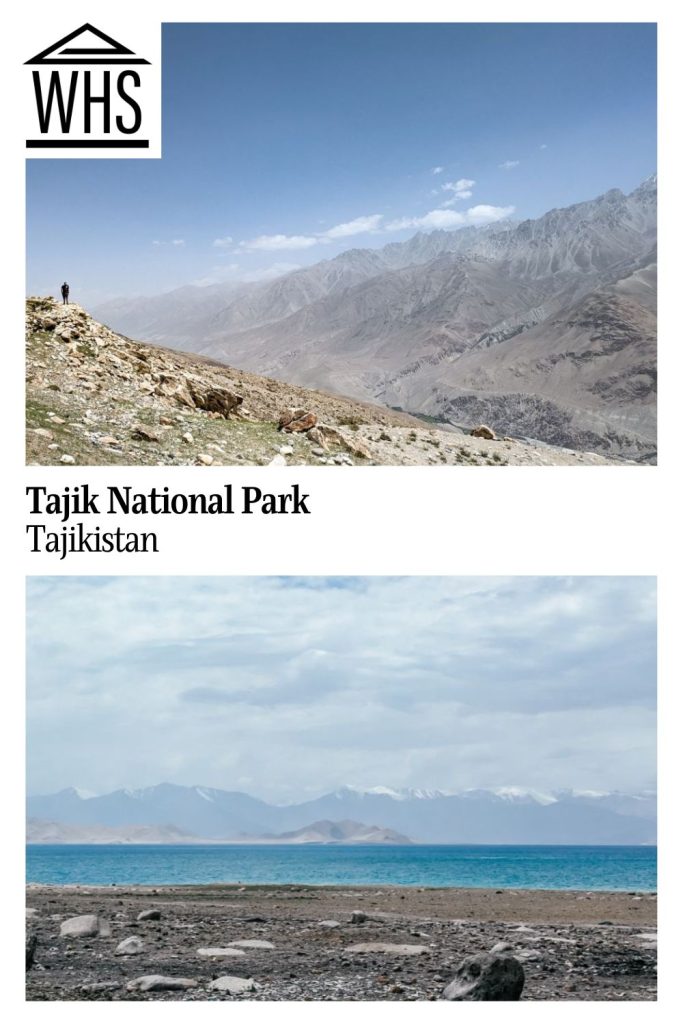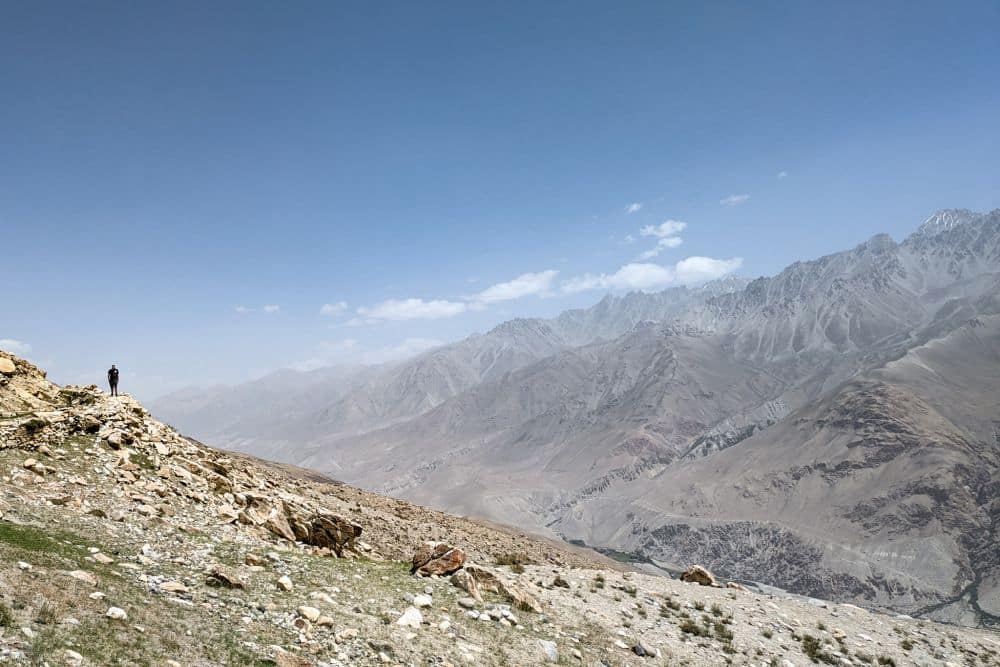Tajik National Park (Mountains of the Pamirs)
By Liza
What is Tajik National Park (Mountains of the Pamirs)?
Tajik National Park, also known as the Mountains of the Pamirs, feels like it belongs on another planet. Nestled in eastern Tajikistan, it stretches across the Gorno-Badakhshan Autonomous Province and parts of the Tavildara and Jirgatal regions.
Tajikistan is a narrow, mountainous country wedged between Afghanistan to the south and Kyrgyzstan to the north. Its landscapes are a mix of vast, barren terrain and towering peaks that will leave you awe-struck. At the centre of this rugged beauty is Tajik National Park, a massive area, home to the iconic Pamir and Fann Mountains—considered some of the most impressive peaks in Central Asia.

Disclosure: This article contains affiliate links. Making a purchase through an affiliate link will mean a small commission for this website. This will not affect your price. Privacy policy.
Tajik National Park is remote and expansive. It covers over 2.6 million hectares (10,000 square miles) and boasts some pretty jaw-dropping scenery. For starters, Peak Somoni, the tallest mountain in the park, soars to an incredible 7,495 meters above sea level (24,590 feet). There are two other mountains that reach over 7,000 meters (23,000 feet), and another 40 peaks over 6,000 meters tall (20,000 feet).
Tajik National Park is as much known for its mountains as its glaciers: over 1,000 of them. Fedchenko Glacier is the most impressive of them all. It is known as the longest glacier in the world outside of the polar regions.
Why is Tajik National Park a UNESCO World Heritage site?
Tajik National Park is the largest protected area in Central Asia and the third highest mountain ecosystem in the world. It was recognised as a UNESCO World Heritage site in 2013, and for good reason.
What sets this park apart is its sheer diversity of landscapes. Picture deep gorges carved by rivers, glaciers, and high-altitude desert plateaus that seem to stretch on forever. According to UNESCO, the park represents “an alpine wilderness of exceptional natural beauty.” It is considered to be of high natural integrity as the park is so remote and has very few permanent human settlements. Tajik National Park is as wild and untouched as it gets. You can be on the most popular hiking routes in peak tourist season and still not see another person. Its remoteness and ruggedness mean that human impact is minimal, allowing the park to remain a pristine slice of nature.
It’s also a living geological laboratory where scientists study everything from plate tectonics to glacial activity. Studies in the park have led to some fundamental scientific understandings of how plate tectonics operate.

What can you expect on a visit to Tajik National Park?
Tajik National Park is truly a special place. I was not quite sure what to expect before my trip, but the sheer scale and raw beauty of the place completely blew me away. Everything here feels larger than life – the peaks, the glaciers, even the silence.
Hiking is the main draw for most visitors, and the options are endless. There are many single-day and multi-day hikes in the park that can be accessed independently. If you are feeling adventurous, there are expedition hikes such as the hike to Fedchenko Glacier, which will need to be done as part of a tour. There is an overnight hike from the town of Barchidev which takes you to the massive, tranquil, Lake Sarez. This is a very young lake, formed in 1911 when an earthquake caused a landslide, which created a natural dam: the highest natural dam in the world. Or you can visit Karakul Lake, which is the highest lake in the world formed by a meteor crater.
Wildlife spotting is another highlight. It is possible to see snow leopards and Marco Polo sheep but they are elusive and can only be found at elevations of about 5000 meters (16,400 feet), so you’d have to be lucky. If you hike in the Tajik National Park, you are sure to see lots of cute, fluffy marmots darting around and maybe even a red fox. The rocky terrain does not support a lot of plant life, but the starkness of the landscape is so unique to this part of the world that it has a charm of its own.

Is this park worth visiting?
Yes, it is definitely worth a visit. Although it is a remote and difficult place to get to, I doubt that any visitor has left there feeling disappointed. It is such a unique place and visiting it feels like a once-in-a-lifetime experience.
Due to its remote location, getting there is generally something that requires a bit of planning. Just to get to Tajikistan is a bit of an undertaking and not somewhere you are likely to pass through if you’re not on a dedicated trip to Central Asia. If you do make the effort to visit the Tajik National Park, I would recommend at least 3-5 days to explore the area. If you are interested in doing trekking or hiking tours, add more time again. Tajik National Park is one of those rare places that feels like a true escape. You will need a bit of time to do it justice.

What sorts of travelers would like Tajik National Park?
Tajik National Park is the perfect destination for adventure travelers. If you like hiking, mountaineering, rock-climbing or even photography, the unique landscapes of the Tajik National Park are sure to blow you away!
Most people who visit Tajik National Park do it as part of a Pamir Highway trip. The Pamir Highway is a road that runs from Osh in Kyrgyzstan to Dushanbe in Tajikistan. Over 1000 km (621 miles) long, it is the second-highest highway in the world and passes through the Tajik National Park and greater Pamir Mountains. I did this trip in 2024 and consider it to be one of my top travel experiences.
Book your accommodations in Osh, Kyrgyzstan, or Dushanbe, Tajikistan.
The accommodation options throughout the Tajik National Park and along the Pamir Highway are generally homestays and guesthouses. They provide everything you need. You will be warm and fed, but they are typically very basic. If you are after a luxurious experience, you will be hard-pressed to find it here.
Tips for visiting the park
Given the remoteness of the park, it is never busy with crowds. Even on some of the more popular hikes, we only encountered another one or two people each day.
The park is located in the Gorno-Badakhshan Autonomous Province. In order to enter this region, you will need to get a special permit, known as the GBAO permit. You can apply for this permit online if you are also applying for a Tajik visa. If you don’t require a visa for Tajikistan, you can purchase your GBAO permit in person in Dushanbe, or through a tour company.
Take a look at this 12-day trip or this 5-day version on the Pamir Highway.
If you plan on taking on some of the stunning hikes within the park, make sure you are prepared for all situations. The weather can change quickly, dust storms are common and the sun and summer heat can be very harsh. Never hike alone and if you are an inexperienced hiker, it is always better to go with a guide.
Where is Tajik National Park?
As the Tajik National Park is so large, there are a number of ways to enter. One of the most popular ways to enter the Tajik National Park is through the Kyzyl Art Pass, a dramatic mountain pass 4336 meters (14,226 feet) above sea level on the Tajik-Kyrgyz border. If you are coming from Kyrgyzstan as part of a Pamir Highway trip, this will likely be your route.
Alternatively, the park can be accessed from Dushanbe by driving 1-2 days depending on conditions. You will need a 4WD to traverse the roads to and within the park. There are also marshrutkas (minivans, taxis or buses along fixed routes) available from towns such as Murghab and Khorog that can take you to towns throughout the park.
For more information about Tajik National Park, see the Tajikistan National Tourism website.
Have you been to Tajik National Park? If so, do you have any additional information or advice about this UNESCO World Heritage site? Please add your comments below!

